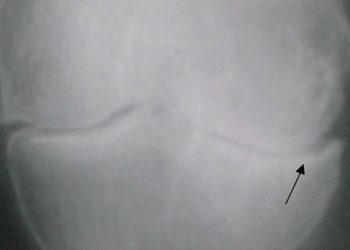Long-term glucosamine sulfate likely improves pain and function in knee osteoarthritis
1. In this systematic review and meta-analysis of patients with knee osteoarthritis (OA) receiving a variety of pharmacologic treatments, glucosamine sulfate was associated with improvement in long-term pain.
2. Glucosamine sulfate was also associated with better physical functioning and joint space narrowing.
Evidence Rating Level: 1 (Excellent)
Study Rundown: There are many treatments for osteoarthritis (OA), which is the most common cause of disability worldwide, including NSAIDs, antioxidants, opioids, glucosamines, bone acting agents, and intraarticular injections. Despite ample research suggesting effective subacute treatments, the use of these strategies for long-term OA pain control is less clear. In this systemic review and meta-analysis, only glucosamine sulfate resulted in significant long-term knee OA pain reduction. Celecoxib was associated with reduced pain in initial analyses, but did not differ when normalizing pain scales and accounting for studies with high risk of bias. Similarly, glucosamine sulfate was associated with improvement in function and joint space narrowing.
While this study highly suggests that glucosamine sulfate is a viable long-term treatment strategy for knee OA, it did not exclude other treatments as being beneficial. On the contrary, the high degree of uncertainty in measurements and large number of treatments surveyed represents significant limitations in statistical power that is likely to diminish the authors’ abilities to detect other truly beneficial treatments, such as NSAIDs.
Click to read the study in JAMA
Relevant Reading: Treatment of osteoarthritis of the knee: an update review
In-Depth [systematic review and meta-analysis]: 47 randomized controlled trials involving 22,037 patients were included in this analysis which evaluated the long-term (>1 year) effects of 31 different interventions including analgesics, NSAIDs, glucosamine derivatives, antioxidants, bone-acting agents, intraarticular injections, corticosteroids, and disease modifying agents. The preferred pain outcome measure was the subscale of the Western Ontario and McMaster University Osteoarthritis Index (WOMAC) while the physical function outcome measure was also prioritized for the WOMAC. Of the 47 included trials, 32 were placebo controlled. There was a large degree of uncertainty surrounding all measurements. Only 2 out of the 31 interventions were associated with significantly improved pain, glucosamine sulfate (Standardized Mean Difference -0.29; CI95 -0.49 to -0.09) and celecoxib (SMD -0.18; CI95 -0.35 to -0.01). When data was analyzed as a mean difference on a scale from 0 to 100, only glucosamine sulfate remained significant (mean difference -4.07; CI95 -6.99 to -1.18). Removing trials with high risk of bias similarly only revealed a difference for glucosamine sulfate (SMD -0.29; CI95 -0.49 to -0.10). Compared with placebo, only glucosamine sulfate was associated with improved physical functioning (SMD -0.32; CI95 -0.52 to -0.12). Three interventions were associated with improved joint space narrowing: glucosamine sulfate (SMD -0.42; CI95 -0.65 to -0), chondroitin sulfate (SMD -0.20; CI95 -0.31 to -0.07), and strontium ranelate (SMD -0.20; CI95 -0.36 to -0.05).
Image: PD
©2018 2 Minute Medicine, Inc. All rights reserved. No works may be reproduced without expressed written consent from 2 Minute Medicine, Inc. Inquire about licensing here. No article should be construed as medical advice and is not intended as such by the authors or by 2 Minute Medicine, Inc.







